New wave of university programs puts Indigenous knowledge at its core
https://www.cbc.ca/news/canada/universities-indigenous-new-programs-1.6588120
https://www.cbc.ca/news/canada/universities-indigenous-new-programs-1.6588120
Making Things Our Own: The Indigenous Aesthetic in Digital Storytelling
This essay makes use of the characteristics of oral storytelling to define indigenous
perspectives on narrative and to provide a framework in which to interpret video and new media art created by Zacharias Kunuk, Nation to Nation’s Cyberpowwow project
and Paula Giese’s Native Ameri can Indian Resources.
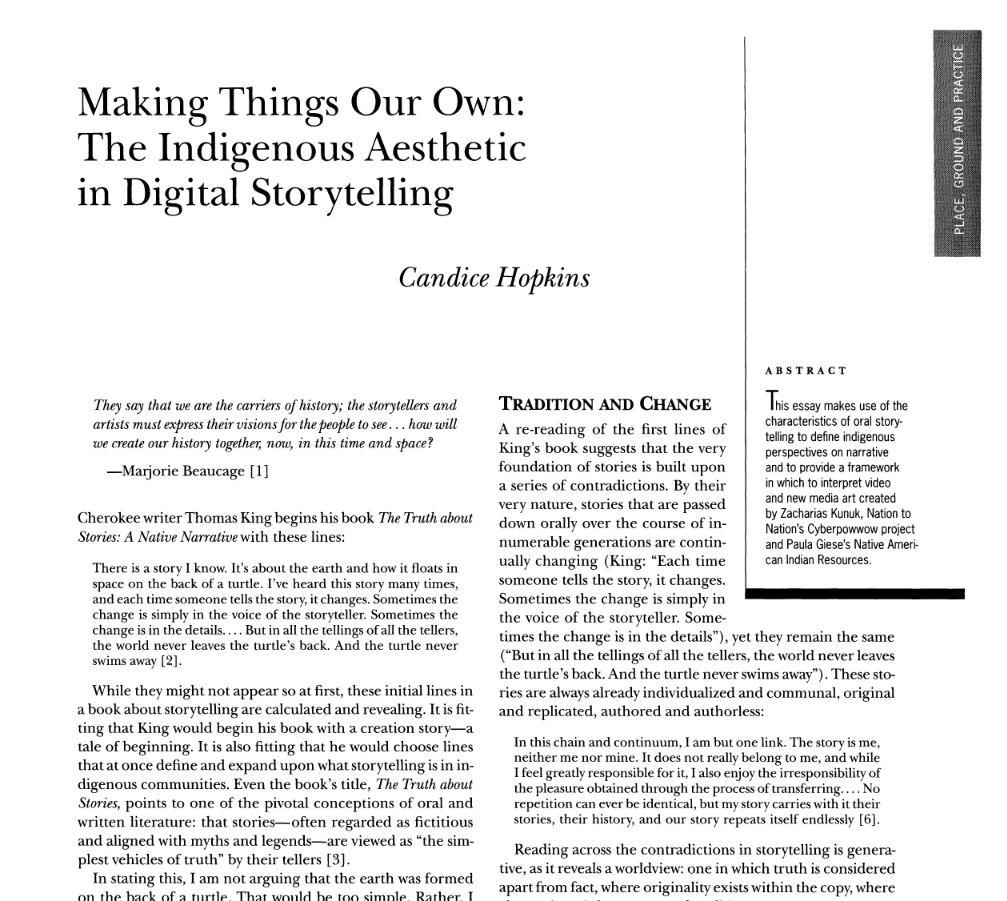
https://muse-jhu-edu.eu1.proxy.openathens.net/article/200347 (login via UBC)
Ohneganos is an Indigenous water research program led by McMaster University Professor, Dr. Dawn Martin Hill.
https://www.ohneganos.com/digital-stories
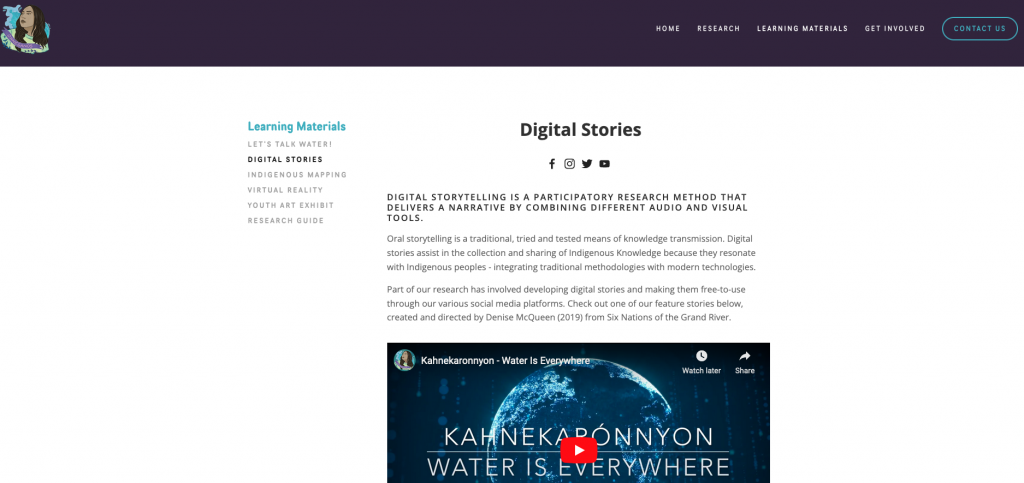
Traditional Storytelling in the Digital Classroom
2013 ETEC 521 assignment by Camille McFarlane focusing on traditional storytelling in the Digital Classroom

Sharing Indigenous Knowledge through inter-generational digital storytelling: Design of a workshop engaging Elders and youth
https://www.tandfonline.com/doi/pdf/10.1080/03601277.2021.1927484?needAccess=true

ETEC 521 Module 2 post 3
https://niemanreports.org/articles/telling-indigenous-stories/
Story about how mainstream media cover Indigenous stories — interesting parallels to Nanook of the North.
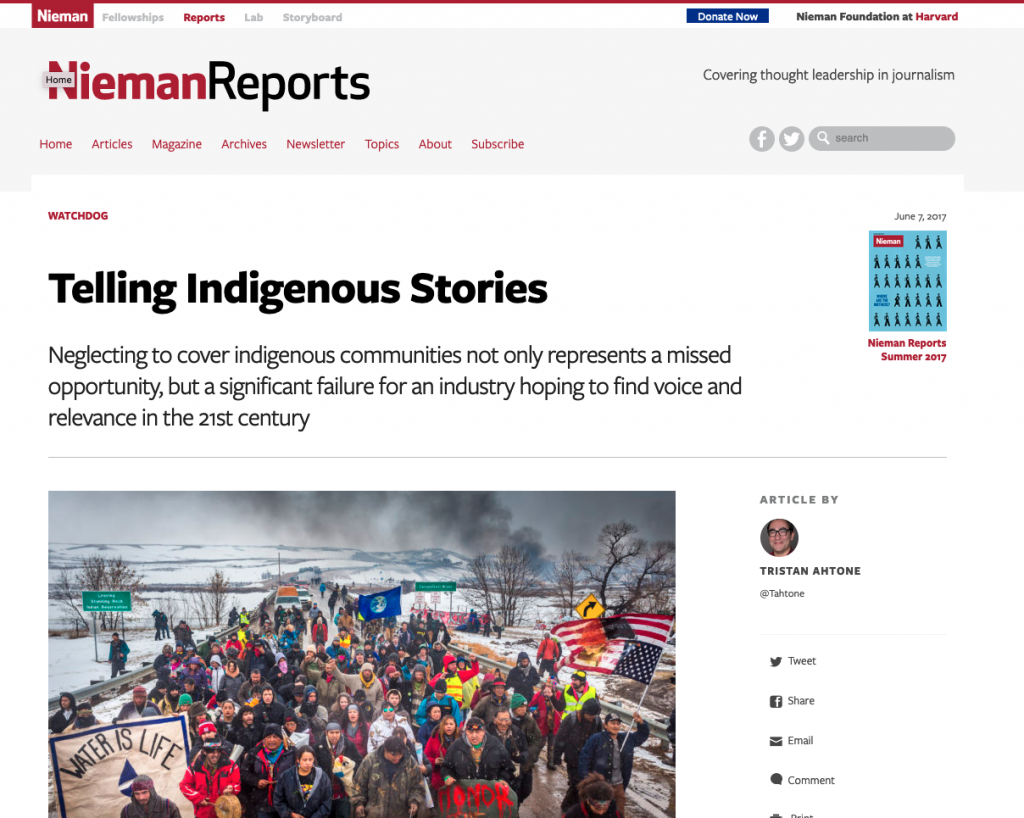
Chapter 11 Storytelling, Culture, and Indigenous Methodology
https://brill.com/view/book/9789004465916/BP000023.xml
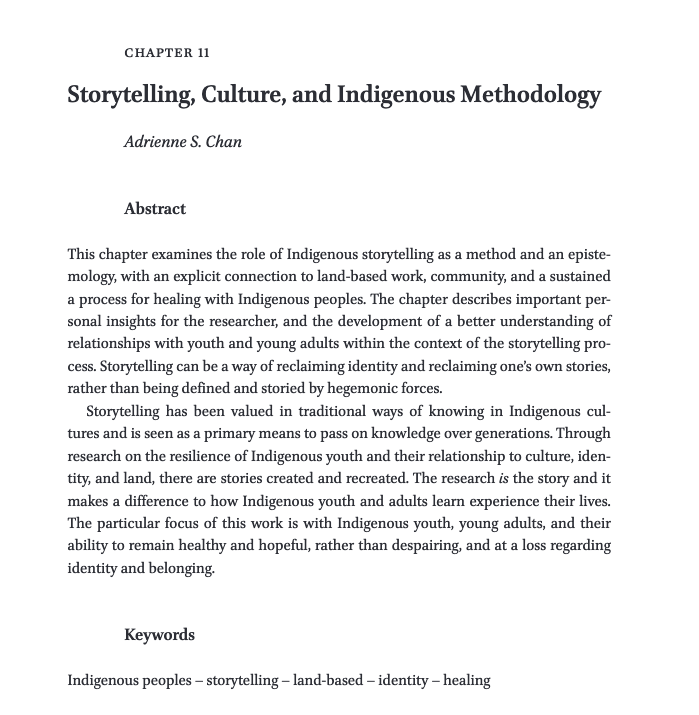
Storytelling in a digital age: digital storytelling as an emerging narrative method for preserving and promoting Indigenous oral wisdom
The IM4 Media Lab Podcast amplifies immersive Indigenous storytelling

A challenge to encourage people to listen to, learn from, and share the stories of Survivors of Indian Residential Schools.
https://next150.indianhorse.ca/challenges/survivor-stories
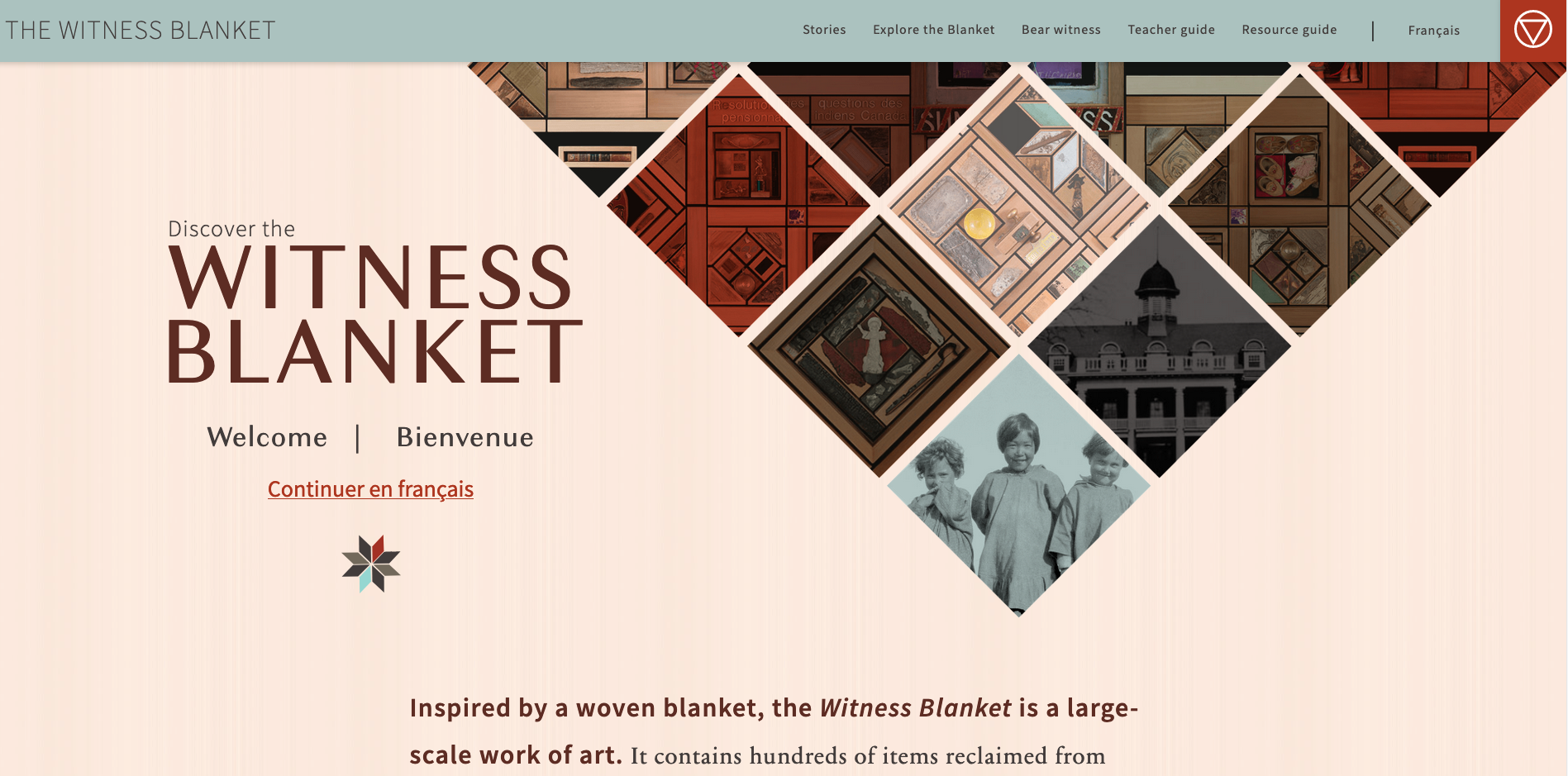
Interactive site showcases residential school stories
Stories of residential school experiences
Additional resources:
https://www.lostinthemovies.com/2008/08/nanook-of-north.html
Website breaks down some of the controversary surrounding Nanook of the North
“Nanook and other Inuit hunters use guns, not spears, to hunt, Nanook’s family isn’t actually his family (they were selected by Flaherty for their roles) and to top it all off Nanook isn’t actually Nanook. His real name was Allakariallak – not quite as catchy.”

Longer “cleaned-up” version of Nanook of the North (1922) posted to Andre Bourbeau in 2020
https://youtu.be/3WFT65hVfU8
– another version posted by RetroTV
Interesting comment included at the YouTube link:
For those interested in the BTS of this film: Be aware that this is not the documented reality of Inuit life at that time and is closer to what we would now consider a fictional retelling. Flaherty, in collaboration with Allakariallak (Nanook’s actual name), staged every scene of his film to show how Inuit used to live. The family isn’t actually one, the clothes were provided by French fur company Revillon, even the igloo is fake (only half of it was built to allow for enough light to come in & to be able to film “inside”). This staging actually makes sense when you consider how heavy & cumbersome filming was at the time – Setting the camera alone would’ve taken such a long time that it would’ve been impossible to follow these people around like in a “2 days in the life of…” modern vlog style. However, Flaherty showed his film to the general public under the guise of “real images” which then spurred controversy. If you consider this documentary as a collaborative project or a reconstructed narrative that says more about film-making in the 20th c. and about the nostalgia Inuit had for a style of life that was quickly disappearing this is a very interesting piece of film-making history. But one cannot forget to replace this in its colonial context which coincidentally was very much omitted as part of the “romanticizing of the Other” trend of the time. note that Eskimo is a Western term that is considered very offensive & the use of Inuit is preferred as this is how this ethnic group referred to themselves as. Inuk = 1 person, Inuit = 3 or more.
Discussion about the influence of Flaherty’s documentary-style film
Frances Flaherty interviewed by Robert Gardner
https://collider.com/nanook-of-the-north-100-anniversary-documentary-robert-flaherty/
A discussion about the impact of Nanook of the North on cinema and documentaries.

YouTube Description of the documentary “Understanding Aboriginal Identity.
Understanding Aboriginal Identity explores the complex issue of self-identification for Aboriginal people. Today, Aboriginal identity remains inextricably linked with past government legislation and the continued stereotyping of Aboriginal people in the media and Canadian history. From a Metis farm in rural Alberta to the offices of Canada’s leading scholars, Understanding Aboriginal Identity examines the factors that shape who we are. To order a copy of this video, contact us at bearpawlegal@ncsa.ca.

Smith, Laurel Catherine, “MEDIATING INDIGENOUS IDENTITY: VIDEO, ADVOCACY, AND KNOWLEDGE IN OAXACA, MEXICO” (2005). University of Kentucky Doctoral Dissertations. 359.
https://uknowledge.uky.edu/gradschool_diss/359
In her PhD dissertation, Dr. Smith outlines how small-scale video and media content can serve as a counter-point to mass media descriptions and coverage of Indigenous Peoples. The article focuses on Mexican Indigenous identity, but includes several references to similar initiatives in Canada.
This week, the University of Waterloo participated in a Commitment Ceremony to affirm its commitment towards decolonization, Indigenization and reconciliation. During the ceremony, Elder Myeengun Henry shared his thoughts on the use of technology.
Some other interesting resources:
Salazar, J. F. (2009). Self-determination in practice: The critical making of indigenous media. Development in Practice, 19(4-5), 504-513. https://doi.org/10.1080/09614520902866397
Grogan, J., Hollinsworth, D., & Carter, J. (2021). Using videoed stories to convey indigenous ‘Voices’ in indigenous studies. The Australian Journal of Indigenous Education, 50(1), 38-46. https://doi.org/10.1017/jie.2019.15
Zoettl, P. A. (2012). Participatory video as a means of reflection and self-reflection about the image and identity of re-emerging indigenous groups in north-eastern brazil. Anthropology in Action (London, England : 1994), 19(2), 17-26. https://doi.org/10.3167/aia.2012.190203
Indigenous Learning Preferences and Interactive Technologies
Andrew KitchenhamSchool of Education, University of Northern British Columbia
Winslett, Gregory M. and Phillips, Jean (2005) ICTs and Indigenous pedagogy: Techniques of resistance in chat rooms. In Proceedings ascilite 2005: Balance, Fidelity, Mobility: maintaining the momentum?, pages pp. 729-734, Queensland University of Technology.
https://eprints.qut.edu.au/6951/1/6951.pdf
Keri Ewart (now with UBC), a Teacher Education instructor, developed an online version of the KAIROS Blanket Exercise to help teacher candidates better understand the shared history of Indigenous and non-Indigenous peoples in Canada from pre-contact to the present day.
Education instructor brings Indigenous history lesson to life online
Integrating indigenous knowledge into appropriate technology development and implementation
John P. Tharakan Howard University
Hafsteinsson, S. B., Bredin, M., & desLibris – Books. (2010;2014;). In Hafsteinsson S. B., Bredin M.(Eds.), Indigenous screen cultures in Canada. University of Manitoba Press.
Grogan, J., Hollinsworth, D., & Carter, J. (2021). Using videoed stories to convey indigenous ‘Voices’ in indigenous studies. The Australian Journal of Indigenous Education, 50(1), 38-46. https://doi.org/10.1017/jie.2019.15
Iseke, J. M. (2011). Indigenous digital storytelling in video: Witnessing with alma desjarlais. Equity & Excellence in Education, 44(3), 311-329. https://doi.org/10.1080/10665684.2011.591685
Knopf, K. (2010). ‘sharing our stories with all canadians’: Decolonizing aboriginal media and aboriginal media politics in canada. American Indian Culture and Research Journal, 34(1), 89-120. https://doi.org/10.17953/aicr.34.1.48752q2m62u18tx2
Kaomea, J., Alvarez, M. B., & Pittman, M. (2019). Reclaiming, sustaining and revitalizing hawaiian education through Video‐Cued makawalu ethnography. Anthropology & Education Quarterly, 50(3), 270-290. https://doi.org/10.1111/aeq.12301
A colleague shared this video (on Instagram) providing a perspective/definition of decolonization.
As I have started to investigate the themes of using video to tell Indigenous stories, I have come across the following sources:
List of sources related to Indigenous technology and education
https://worldwidescience.org/topicpages/i/indigenous+technology+education.html
The Teaching for Indigenous Education website responds to the changing educational landscape that recognizes the importance of educational frameworks based on Indigenous perspectives
https://ets.educ.ubc.ca/innovation/special-projects/teaching-for-indigenous-education/
-link to project however is broken
Implementing Indigenous Education with Technology Education in British Columbia
Indigenous peoples teach the world First Nations wisdom through technology
https://www.weforum.org/agenda/2022/08/indigenous-people-augmented-reality/
This project begins by outlining why Indigenous education and technology education need to be more closely connected.
https://dspace.library.uvic.ca/handle/1828/12903?show=full
O’Shea, J. (2021). Implementing indigenous education with technology education in British Columbia
Why The Time For Indigenous-led Innovation In Tech Is Now, And How To Support It
https://technologycouncil.ca/2022/02/07/why-the-time-for-indigenous-led-innovation-in-tech-is-now/
Indigenous Technology in Technology Education Curricula and Teaching. Gumbo, Mishack (University of South Africa)
The use of ICTs and E-learning in Indigenous Education
Kevin O’Connor, Mount Royal University
https://k12sotn.ca/papers/the-use-of-icts-and-e-learning-in-indigenous-education/
The affordances of technology for teaching Indigenous knowledge
Olivier, Jacko et al (2019)
Olivier, Jako & Van der Westhuizen, Cp & Laubscher, Dorothy & Bailey, Roxanne. (2019). The affordances of technology for teaching indigenous knowledge. 10.4102/aosis.2019.BK133.10.
WEAVING WAYS INDIGENOUS WAYS OF KNOWING IN CLASSROOMS AN D SCHOOLS
Alberta Regional Professional Development Consortium
MULTIMEDIA TECHNOLOGY AND INDIGENOUS LANGUAGE REVITALIZATION: PRACTICAL EDUCTIONAL TOOLS AND APPLICATIONS USED WITHIN NATIVE COMMUNITIES
PhD dissertation from University of Arizona
http://www.malsmb.ca/docs/multimedia-technology-and-indigenous-language-revitalization.pdf
Determinants of Indigenous Student Learning with Digital Technology: A Qualitative Study in a Remote Manitoba First Nations Community
PhD dissertation from University of Manitoba
https://mspace.lib.umanitoba.ca/bitstream/handle/1993/32752/Ben%20Akoh.pdf?sequence=3

A resource page entitled First Nations Pedagogy Online provides links to helpful multimedia sites.
I found a great article by some researchers in Australia related to the use of video when documenting Indigenous stories and cultural practices. The article includes a discussion of consent, ethics, and ethnography.
The above article references a few other articles that could be helpful:

Technology amplifies Indigenous knowledge is discussed within this website article authored by Mikaela Jade. According to the article, augmented reality and other technologies can play a role in fostering cultural connection and digital skills.
https://www.weforum.org/agenda/2022/08/indigenous-people-augmented-reality/
The Christensen Fund supports Indigenous Peoples in advancing their inherent rights, dignity and self-determination. The site includes a video project from 2011 that showcases the personal accounts of elders on the topics of sacred sites, land, language, culture, and the future.
https://www.christensenfund.org/programs/

University College of the North website hosts an Elder’s traditional knowledge section including videos and other resources featuring elders from northern Manitoba